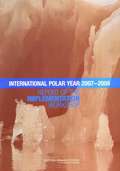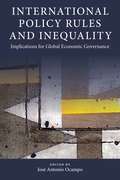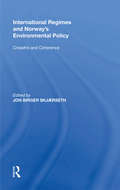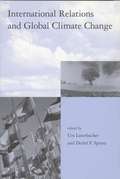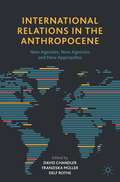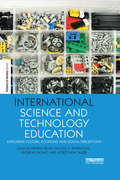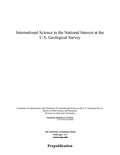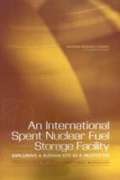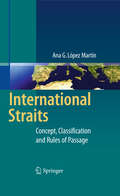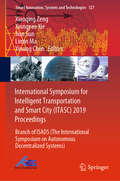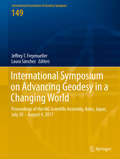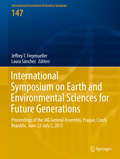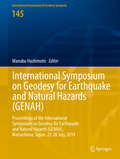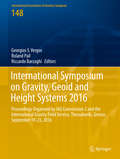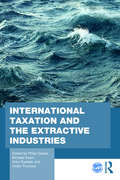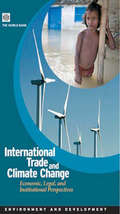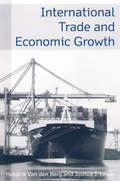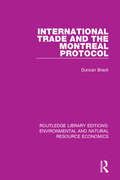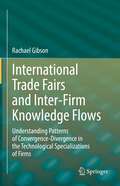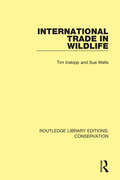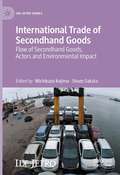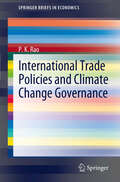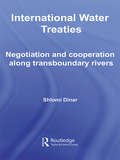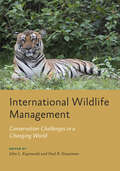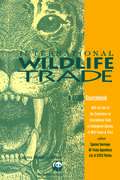- Table View
- List View
International Polar Year 2007-2008: Report Of The Implementation Workshop
by Polar Research BoardThe National Academies Press (NAP)--publisher for the National Academies--publishes more than 200 books a year offering the most authoritative views, definitive information, and groundbreaking recommendations on a wide range of topics in science, engineering, and health. Our books are unique in that they are authored by the nation's leading experts in every scientific field.
International Policy Rules and Inequality: Implications for Global Economic Governance (Initiative for Policy Dialogue at Columbia: Challenges in Development and Globalization)
by José Antonio OcampoOver the past decades, the world has seen a dramatic increase in inequality. To what extent have the rules that govern the global economy, formally or informally, affected this trend? How can global governance arrangements be reformed to counteract them?In this book, an interdisciplinary group of prominent scholars scrutinizes how the rules of global economic governance—or the lack thereof—determine the extent and growth of inequality. Economists, political scientists, lawyers, and other experienced contributors bring together cutting-edge research on global rule making and inequality, exploring how international rules can exacerbate inequalities among and within countries to show the crucial interactions between policy choices and the distribution of income and wealth. They provide an in-depth examination of the rules governing foreign-investment protection, cross-border financial flows, and intellectual property rights, as well as the lack of standards governing international taxation and the channels through which they might affect inequality. With a focus on ambitious and achievable reforms, this book offers concrete steps toward global economic governance capable of counteracting inequitable wealth distribution and bringing about fairer economic growth.
International Regimes and Norway's Environmental Policy: Crossfire and Coherence
by Jon Birger Skj�ethSince the former Norwegian prime minister, Gro Harlem Brundtland, led the World Commission on Sustainable Development, Norway has played an important role in international environmental co-operation. This volume looks at how this one state engaged international regimes in order to pursue its own national goals in the following issue areas: climate change, biodiversity, ozone depletion, air pollution, marine pollution and whaling. In doing so, it offers an innovative new approach to the study of international regime effectiveness and on linkages or interactions between international regimes.
International Relations and Global Climate Change
by Urs Luterbacher Detlef F. SprinzThis book surveys current conceptual, theoretical, and methodological approaches to global climate change and international relations. Although it focuses on the role of states, it also examines the role of nonstate actors and international organizations.
International Relations in the Anthropocene: New Agendas, New Agencies and New Approaches
by David Chandler Delf Rothe Franziska MüllerThis textbook introduces advanced students of International Relations (and beyond) to the ways in which the advent of, and reflections on, the Anthropocene impact on the study of global politics and the disciplinary foundations of IR. The book contains 24 chapters, authored by senior academics as well as early career scholars, and is divided into four parts, detailing, respectively, why the Anthropocene is of importance to IR, challenges to traditional approaches to security, the question of governance and agency in the Anthropocene, and new methods and approaches, going beyond the human/nature divide.
International Science and Technology Education: Exploring Culture, Economy and Social Perceptions (The Earthscan Science in Society Series)
by Ortwin Renn Nicole C. Karafyllis Andreas Hohlt Dorothea TaubeEducation in science, technology, engineering and mathematics (STEM) is crucial for taking advantage of the prospects of new scientific discoveries initiating or promoting technological changes, and managing opportunities and risks associated with innovations. This book explores the emerging perspectives and methodologies of STEM education and its relationship to the cultural understanding of science and technology in an international context. The authors provide a unique perspective on the subject, presenting materials and experiences from non-European industrialized as well as industrializing countries, including China, Japan, South Korea, India, Egypt, Brazil and the USA. The chapters offer a wide scope of interpretations and comparative reviews of STEM education by including narrative elements about cultural developments, considering the influence of culture and social perceptions on technological and social change, and applying innovative tools of qualitative social research. The book represents a comprehensive and multidisciplinary review of the current status and future challenges facing STEM education across the world, including issues such as globalization, interdependencies of norms and values, effects on equity and social justice as well as resilience. Overall the volume provides valuable insights for a broad and comprehensive international comparison of STEM philosophies, approaches and experiences.
International Science in the National Interest at the U.S. Geological Survey
by National Research Council Division on Earth and Life Studies Board on Earth Sciences and Resources Committee on Opportunities and Challenges for International Science at the U.S. Geological SurveyScience at the U.S. Geological Survey (USGS) is intrinsically global, and from early in its history, the USGS has successfully carried out international projects that serve U.S. national interests and benefit the USGS domestic mission. Opportunities abound for the USGS to strategically pursue international science in the next 5-10 years that bears on growing worldwide problems having direct impact on the United States--climate and ecosystem changes, natural disasters, the spread of invasive species, and diminishing natural resources, to name a few. Taking a more coherent, proactive agency approach to international science--and building support for international projects currently in progress-would help the USGS participate in international science activities more effectively.
An International Spent Nuclear Fuel Storage Facility: EXPLORING A RUSSIAN SITE AS A PROTOTYPE
by National Research Council of the National AcademiesAs part of a long-standing collaboration on nuclear nonproliferation, the National Academy of Sciences and the Russian Academy of Sciences held a joint workshop in Moscow in 2003 on the scientific aspects of an international radioactive disposal site in Russia. The passage of Russian laws permitting the importation and storage of high-level radioactive material (primarily spent nuclear fuel from reactors) has engendered interest from a number of foreign governments, including the U.S., in exploring the possibility of transferring material to Russia on a temporary or permanent basis. The workshop focused on the environmental aspects of the general location and characteristics of a possible storage site, transportation to and within the site, containers for transportation and storage, inventory and accountability, audits and inspections, and handling technologies.
International Straits
by Ana G. López MartínThis book analyzes the regime of navigation in historical relation to the United Nations Convention of the Law of Sea (UNCLOS) of 10 December 1982, and then analyzes in detail the concept of international straits to arrive at a complete definition. This work examines the eight categories of straits laid out in the UNCLOS. It analyzes the right of innocent passage and the regime of transit passage, both systems of navigation in international straits, and then presents the domestic legislation and the traffic separation schemes which apply to international straits. Finally, the work includes a complete catalogue of straits with the reference to their respective UNCLOS articles.
International Symposium for Intelligent Transportation and Smart City: Branch of ISADS (The International Symposium on Autonomous Decentralized Systems) (Smart Innovation, Systems and Technologies #127)
by Xiaoqing Zeng Xiongyao Xie Jian Sun Limin Ma Yinong ChenThis book presents research advances in intelligent transportation and smart cities in detail, mainly focusing on green traffic and urban utility tunnels, presented at the 4th International Symposium for Intelligent Transportation and Smart City (ITASC) held at Tongji University, Shanghai, on May 8–10, 2019. It discusses a number of hot topics, such as the 2BMW system (Bus, Bike, Metro and Walking), transportation safety and environmental protection, urban utility design and application, as well as the application of BIM (Building Information Modeling) in city design. By connecting the theory and applications of intelligent transportation in smart cities, it enhances traffic efficiency and quality. The book gathers numerous selected papers and lectures, including contributions from respected scholars and the latest engineering advances, to provide guidance to researchers in the field of transportation and urban planning at universities and in related industries.The first conference in the ITASC series was held in 2013 as a workshop of the International Symposium on Autonomous Decentralized System (ISADS) in Mexico City. The second and third were held in May 2015 and May 2017, respectively, in Tongji University, Shanghai.
International Symposium on Advancing Geodesy in a Changing World: Proceedings of the IAG Scientific Assembly, Kobe, Japan, July 30 – August 4, 2017 (International Association of Geodesy Symposia #149)
by Jeffrey T. Freymueller Laura SánchezThese proceedings contain 23 papers, which are the peer-reviewed versions of presentations made at the Joint Scientific Assembly of the International Association of Geodesy (IAG) and the International Association of Seismology and Physics of the Earth’s Interior (IASPEI). The assembly was held from 30 July to 4 August 2017 in Kobe, Japan. The scientific assembly included seven symposia organized by IAG, and nine joint symposia, along with additional symposia organized by IASPEI. The IAG symposia were structured according to the four IAG Commissions and the three GGOS Focus Areas, and included reference frames, static and time-variable gravity field, Earth rotation and geodynamics, multi-signal positioning, geodetic remote sensing, and GGOS. The joint symposia included monitoring of the cryosphere, studies of earthquakes, earthquake source processes, and other types of fault slip, geohazard warning systems, deformation of the lithosphere, and seafloor geodesy. Together, the IAG and joint symposia spanned a broad range of work in geodesy and its applications.
International Symposium on Earth and Environmental Sciences for Future Generations: Proceedings of the IAG General Assembly, Prague, Czech Republic, June 22- July 2, 2015 (International Association of Geodesy Symposia #147)
by Laura Sánchez Jeffrey T. FreymuellerThis book series is composed of peer-reviewed proceedings of selected symposia organized by the International Association of Geodesy. It deals primarily with topics related to Geodesy Earth Sciences : terrestrial reference frame, Earth gravity field, Geodynamics and Earth rotation, Positioning and engineering applications.
International Symposium on Geodesy for Earthquake and Natural Hazards (GENAH)
by Manabu HashimotoThese proceedings contain a selection of peer-reviewed papers presented at the International Symposium on Geodesy for Earthquake and Natural Hazards (GENAH), Matsushima, Japan, 22-26 July, 2014. The scientific sessions focused on monitoring temporal and spatial changes in Earth's lithosphere and atmosphere using geodetic satellite systems, high rate GNSS as well as high resolution imaging (InSAR, Lidar). Researchers in various fields of geodesy discussed the role of geodesy in disaster mitigation and how groups with different techniques can collaborate toward such a goal.
International Symposium on Gravity, Geoid and Height Systems 2016: Proceedings Organized by IAG Commission 2 and the International Gravity Field Service, Thessaloniki, Greece, September 19-23, 2016 (International Association of Geodesy Symposia #148)
by Georgios S. Vergos Roland Pail Riccardo BarzaghiThese proceedings contain 27 papers, which are the peer-reviewed versions of presentations made at the International Association of Geodesy (IAG) symposium “Gravity, Geoid and Height Systems 2016” (GGHS2016). GGHS2016 was the first Joint international symposium organized by IAG Commission 2 “Gravity Field”, the International Gravity Field Service (IGFS) and the GGOS Focus Area “Unified Height System”. It took place in Thessaloniki, Greece, in September 19-23, 2016 at the premises of the Aristotle University of Thessaloniki. The symposium was organized by the Department of Geodesy and Surveying of the Aristotle University of Thessaloniki, which presently hosts the IGFS Central Bureau. The focus of the Symposium was on methods for observing, estimating and interpreting the Earth gravity field as well as its applications. GGHS2016 continued the long and successful history of IAG’s Commission 2 Symposia.
International Taxation and the Extractive Industries: Resources without Borders (Routledge Studies in Development Economics)
by Philip Daniel Michael Keen Artur Świstak Victor ThuronyiThe taxation of extractive industries exploiting oil, gas, or minerals is usually treated as a sovereign, national policy and administration issue. This book offers a uniquely comprehensive overview of the theory and practice involved in designing policies on the international aspects of fiscal regimes for these industries, with a particular focus on developing and emerging economies. <P><P>International Taxation and the Extractive Industries addresses key topics that are not frequently covered in the literature, such as the geo-political implications of cross-border pipelines and the legal implications of mining contracts and regional financial obligations. The contributors, all of whom are leading researchers with experience of working with governments and companies on these issues, present an authoritative collection of chapters. The volume reviews international tax rules, covering both developments in the G20-OECD project on ’Base Erosion and Profit Shifting’ and more radical proposals, identifying core challenges in the extractives sector. <P><P>This book should become a core resource for both scholars and practitioners. It will also appeal to those interested in international tax issues more widely and those who study environmental economics, macroeconomics and development economics.
International Trade and Climate Change: Economic, Legal, and Institutional Perspectives
by World BankClimate change remains a global challenge requiring international collaborative action. Another area where countries have successfully committed to a long-term multilateral resolution is the liberalization of international trade. Integration into the world economy has proven a powerful means for countries to promote economic growth, development, and poverty reduction. The broad objectives of the betterment of current and future human welfare are shared by both global trade and climate regimes. Yet both climate and trade agendas have evolved largely independently through the years, despite their mutually supporting objectives. Since global emission goals and global trade objectives are shared policy objectives of most countries, and nearly all of the World Bank's clients, it makes sense to consider the two sets of objectives together. This book is one of the first comprehensive attempts to look at the synergies between climate change and trade objectives from economic, legal, and institutional perspectives. It addresses an important policy question - how changes in trade policies and international cooperation on trade policies can help address global environmental spillovers, especially GHG emissions, and what the (potential) effects of (national) environmental policies that are aimed at global environmental problems might be for trade and investment. It explores opportunities for aligning development and energy policies in such a way that they could stimulate production, trade, and investment in cleaner technology options.
International Trade and Economic Growth
by Van den Hendrik Joshua J LewerUnlike any other text on international trade, this groundbreaking book focuses on the dynamic long-run relationship between trade and economic growth rather than the static short-run relationship between trade and economic efficiency. The authors begin with well-known theory on international trade, and then take the student into more recent and less well-known work, all with a careful balance between empirical and theoretical perspectives. A valuable teaching tool for courses in international economics, economic growth, and economic development at both the undergraduate and graduate levels, the book uses some very modest algebra, calculus, and statistics. However, most analytical discussions are built around diagrams in order to make the text accessible to students with a variety of social science backgrounds. An Instructor's Manual is available to professors who adopt the text.
International Trade and the Montreal Protocol (Routledge Library Editions: Environmental and Natural Resource Economics)
by Duncan BrackOriginally published in 1996. The Montreal Protocol on Substances that Deplete the Ozone Layer is one of the most effective multilateral environmental agreements currently in existence. Established to control the production and consumption of CFCs and other ozone-depleting chemicals, the Protocol is an important example of an agreement which places restrictions on international trade in the interests of the global environmental – a feature which may become common in future treaties. This report examines the development, effectiveness and future of the trade provisions of the ozone regime, concluding that they have contributed significantly to its success in attracting signatories and in limiting ozone depletion. Issues considered include the compatibility of the trade provisions and the GATT, trade restrictions and developing countries, and the new problems of non-compliance and illegal trade in CFCs.
International Trade Fairs and Inter-Firm Knowledge Flows: Understanding Patterns of Convergence-Divergence in the Technological Specializations of Firms
by Rachael GibsonAgainst a backdrop of economic uncertainty caused by a shift toward protectionism and the COVID-19 pandemic among other issues, this book suggests that international trade fairs (ITFs) represent a vital source of economic dynamism that can support national and regional economies by creating opportunities for firms to access new markets, network with key actors in their industry or value chain, and tap into valuable external knowledge flows regarding new technologies and innovations. Author Rachael Gibson argues that ITFs have become crucial nodes in the global political economy, driving global economic dynamics and mediating differences between capitalist economies regarding their technological and institutional practices and conditions. In this way, ITFs represent a decisive mechanism by which distinct national patterns of technological specialization may converge or diverge.Trade fairs represent important platforms for networking, interactive learning, and knowledge exchange because they foster intense interactions among actors despite spatial boundaries. ITFs also tend to be organized according to a specific technological or industry focus, which means that they can facilitate interactions between firms from different capitalist varieties. Through the diffusion of state-of-the-art knowledge, ITFs may, thus, serve as drivers of economic globalization, challenging the continuation of distinct capitalist varieties by enabling cross-system convergence regarding the technological specializations of firms. Yet, it is clear that countries have retained competitive advantages in specific industries and that full convergence has not taken place. This book explores this puzzle.
International Trade in Wildlife (Routledge Library Editions: Conservation #2)
by Tim Inskipp Sue WellsOriginally published in 1979 International Trade in Wildlife is a product of the 1973 Convention on International Trade in Endangered Species of Wild Fauna and Flora conference, containing the full text of the CITIES convention. The volume outlines the animals and plants controlled by CITIES, and describes the protective policies put in place to protect endangered plants and animals. It gives a detailed background to the international traffic in monkey’s, spotted cats, whales, ivory, parrots, tortoises, marine turtles, crocodiles, butterflies, sponges and rare orchids at the time of publication and acts as a comprehensive document on the conservation policies enacted through CITIES, as well as facts surrounding the decline of endangered species. Although published over 40 years ago, the document still offers a comprehensive and useful guide to conservation and will be an important historical document for environmental policy makers and conservationists alike.
International Trade of Secondhand Goods: Flow of Secondhand Goods, Actors and Environmental Impact (IDE-JETRO Series)
by Michikazu Kojima Shozo SakataThis book demonstrates the flow of the international trade of secondhand goods and examines the socio-economic background and mechanisms of the trade. It highlights the actors involved in the trade of secondhand goods and how traditionally secondhand good have largely been traded through social or ethnic networks in order to effectively transfer quality and market information. The development of information technology and emergence of new information platforms have changed these business models. The policies and regulations relating to the trade of secondhand goods are explored, alongside the negative impact of these trades, and the growing awareness of the circular economy. This book illustrates how importing countries as well as international institutions have developed regulations in order to balance these two issues. It will relevant to students and economists interested in development economics and economics geography.
International Trade Policies and Climate Change Governance
by P. K. RaoThis work offers a synthesis of the current approaches toward an integration of international trade and climate change, with a view to fostering potential improvements in policies and institutions affecting these. A number of pragmatic measures are proposed with reference to the WTO and the United Nations Framework Convention on Climate Change (UNFCCC) regimes, which are expected to contribute toward enhanced climate change governance, as well as promoting international trade.
International Water Treaties: Negotiation and Cooperation Along Transboundary Rivers (Routledge Studies in the Modern World Economy)
by Shlomi DinarAs demand for fresh water rises, together with population, water scarcity already features on the national security agenda of many countries. In this book, Dinardevelops a theory to explain solutions to property rights conflicts over shared rivers. Through systematic analysis of available treaty texts, corresponding side-payment and cost-sharing patterns are gleaned. Geographic and economic variables are used to explain recurring property rights outcomes. Rather than focusing on a specific river or particular geographic region, the book analyzes numerous rivers, dictated by the large number of treaty observations, and is able to test several hypotheses, devising general conclusions about the manner in which states resolve their water disputes. Policy implications are thereby also gained. While the book simultaneously considers conflict and cooperation along international rivers, it is the focus on negotiated agreements, and their embodied side-payment and cost-sharing regimes, that justifies the use of particular independent variables.
International Wildlife Management: Conservation Challenges in a Changing World (Wildlife Management and Conservation)
by John L. Koprowski and Paul R. KrausmanA call for wildlife conservationists to transcend the boundaries of locality, share best practices, and unite with a common voice to influence global policy.Habitat loss, disease management, predator-human conflict, illegal trade—these are among the many conservation challenges faced by wildlife experts around the world. But how wildlife professionals approach these issues has historically been geographically fragmented. By providing a broad perspective on issues faced by wildlife on an international scale, the authors of International Wildlife Management make vital connections, drawing attention to underlying causes and strategies for mitigation that may look surprisingly similar from Montana to Zimbabwe. Bringing together wildlife professionals from around the globe to discuss shared challenges, International Wildlife Management• examines widespread patterns of wildlife loss• covers key conservation strategies, including species reintroduction, community engagement, and wildlife commerce• explores the urgent concerns of climate change, habitat loss and fragmentation, invasive species, and poaching• reviews major organizations involved in wildlife management at an international level, highlighting examples of cooperation among groups and nations in effective wildlife management efforts• features stories of success and struggle from authors across 17 countries on 6 continents This timely and thorough overview thinks big by assessing threats to wildlife on a global scale. Wild creatures don't recognize artificial geographic borders. This useful compendium demonstrates that researchers and scientists should follow their lead.
International Wildlife Trade: A Cites Sourcebook
by Ginette Hemley Kathryn FullerFor more than two decades, the Convention on International Trade in Endangered Species of Wild Fauna and Flora, known as CITES, has been one of the largest and most effective conservation agreements in the world. By regulating international commerce in certain species -- from African elephants and exotic birds to hardwoods and bulbs -- the treaty limits trade in species that are in genuine need of protection while allowing controlled trade in species that can withstand some level of exploitation.In addition to explaining how CITES operates, this definitive reference includes: the full text of the CITES treatyCITES Appendices I, II, and III a list of Parties as of March 1994 a list of reservations by Parties as of October 1993 Chapters address the status of highly threatened species such as elephants, rhinos, and tigers as well as other heavily exploited species including parrots, primates, and bears.International Wildlife Trade provides a valuable overview of wildlife trade issues, and of the strengths and weaknesses of the current treaty.
